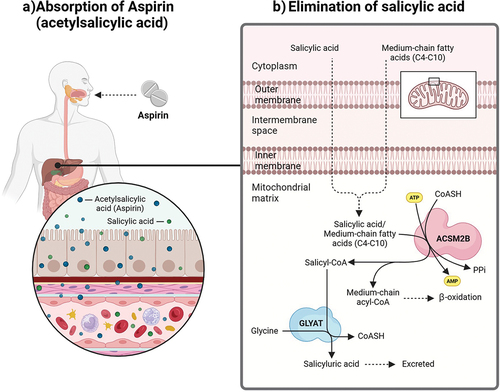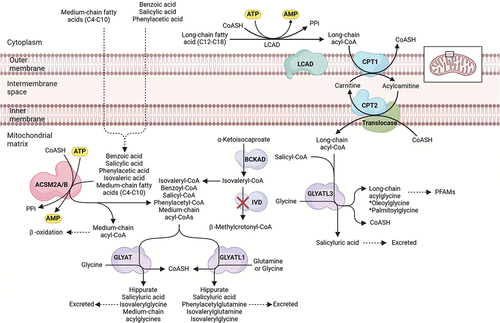Figures & data
Figure 1. The absorption of aspirin and the excretion of salicylic acid.
(a) The absorption of aspirin from the intestinal lumen into the bloodstream by passive diffusion leads to the rapid inactivation of platelets within the presystemic portal vein prior to first-pass metabolism in the liver. (b) Elimination of salicylic acid within the mitochondrial matrix. Salicylic acid circulating in the bloodstream enters the liver for detoxification by glycine conjugation. Salicylic acid freely diffuses into the mitochondrial matrix where the carboxylic acid is firstly activated to an acyl-CoA by ACSM2B, followed by a conjugation reaction with glycine as mediated by GLYAT. The resulting glycine conjugate of salicylic acid, salicyluric acid, is excreted in the urine and Coenzyme A (CoASH) is recycled within the mitochondria.
Abbreviations: ACSM2B, Xenobiotic/medium chain fatty acid: CoA ligase; AMP, Adenosine monophosphate; ATP, Adenosine triphosphate; CoASH, Coenzyme A, GLYAT, Glycine N-acyltransferase; PPi, Pyrophosphate. Created with BioRender.com

Figure 2. Paralogues of GLYAT and ACSM2B as possible detoxification enzymes of salicylic acid.
This diagram depicts the glycine conjugation pathway present within the mitochondrial matrix, outlining the two-step reaction by which endogenous and exogenous carboxylic acids are detoxified from the body. Medium-chain fatty acids and xenobiotic carboxylic acids enter the mitochondria freely, and these acids are then activated to their corresponding acyl-CoA either by ACSM2A or ACSM2B. Organic acids (i.e. isovaleric acid) accumulate within the mitochondria as isovaleryl-CoA due to the inability of Isovaleric acidemia (IVA) patients to completely degrade leucine. The acyl-CoAs of various origins are conjugated with glycine or glutamine based on the preferred enzymatic reaction as mediated either by GLYAT or GLYATL1. The resulting glycine conjugates are excreted from the body. The entry of long-chain fatty acids into the mitochondrial matrix is mediated via the carnitine transport system and activated to their corresponding acyl-CoA. Subsequently, GLYATL3 conjugates long-chain acyl-CoAs with glycine to form their corresponding acylglycines, which are then converted to primary fatty acid amides (PFAMs). The possibility of all three glycine conjugating enzymes to detoxify salicylic acid remains credible.
Abbreviations: ACSM2A/B, Xenobiotic/medium chain fatty acid: CoA ligase; AMP, Adenosine monophosphate; ATP, Adenosine triphosphate; BCKAD, Branched-chain α-ketoacid dehydrogenase; CoASH, Coenzyme A; CPT1, Carnitine O-palmitoyltransferase 1; CPT2, Carnitine O-palmitoyltransferase 2; GLYAT, Glycine N-acyltransferase; GLYATL1, Glutamine N-acyltransferase-like 1; GLYATL3, Glycine N-acyltransferase-like 3; IVD, Isovaleryl-CoA dehydrogenase; LCAD, Long-chain acyl-CoA dehydrogenase; PFAMs, Primary fatty acid amides; PPi, Pyrophosphate, Translocase, Carnitine/acylcarnitine translocase. Created with BioRender.com

